Orange-fronted parakeet
The orange-fronted parakeet or orange-fronted conure (Eupsittula canicularis), also known as the half-moon conure, is a medium-sized parrot that is resident from western Mexico to Costa Rica.
| Orange-fronted parakeet | |
|---|---|
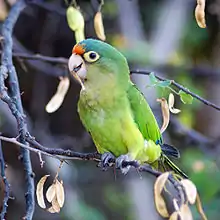 | |
| In a tree feeding on seeds, Gulf of Papagayo, Costa Rica | |
| Scientific classification | |
| Kingdom: | Animalia |
| Phylum: | Chordata |
| Class: | Aves |
| Order: | Psittaciformes |
| Family: | Psittacidae |
| Genus: | Eupsittula |
| Species: | E. canicularis |
| Binomial name | |
| Eupsittula canicularis | |
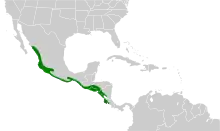 | |
| Synonyms | |
| |
Taxonomy
There are three subspecies:[2]
- E. c. clarae – (R. T. Moore, 1937): found in west central Mexico
- E. c. eburnirostrum – (Lesson, 1842): found in southwestern Mexico
- E. c. canicularis – (Linnaeus, 1758): found from southern Mexico to western Costa Rica
Description
Orange-fronted parakeets are 22.5 cm (8.9 in) long and weigh 80 g (2.8 oz). The adult is mainly green, paler and yellower below and with an olive tone to the breast. The wings have blue outer primaries and yellow linings, and the pointed tail is tipped with blue. The head is distinctive, with a blue crown, orange forehead, bare yellow eye-ring, yellow iris and white bill. Young birds are similar to the adults, but with much less orange on the forehead.
Habitat and range
It is found in lowlands and foothills on the Pacific side of the central mountain ranges in forest canopy and edges, and more open woodland, including savanna and second growth.
Behaviour
The orange-fronted parakeet feeds in flocks which can reach 100 birds outside the breeding season, taking various seeds, flowers and fruits including figs. Its flight call is a raucous can-can-can, and when perched it has a reedy zeeweet.
Breeding
The 3–5 white eggs are laid in an unlined nest cavity, usually self-excavated in an arboreal termite nest of the termite species Nasutitermes nigriceps,[3] but sometimes in an old woodpecker hole or natural cavity.
Aviculture
The orange-fronted parakeet (more commonly known as the half-moon conure in aviculture) is sometimes kept as a companion parrot. An excitable, energetic bird that enjoys climbing and playing, it tends to be quieter than some other conure species and is good-natured when properly socialized. It is not noted as a talking bird, but may mimic a few words or sounds. In order to remain healthy, it requires regular mental stimulation and time outside of its cage in which to fly.[4]
The population has decreased in many areas due to persecution for the pet trade.
Gallery
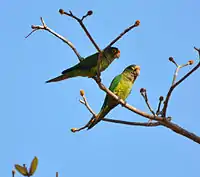 Two birds in Costa Rica
Two birds in Costa Rica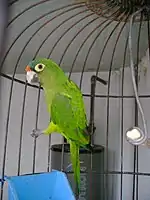 Pet orange-fronted parakeet
Pet orange-fronted parakeet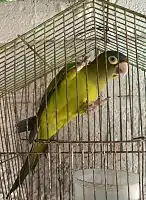 Pet orange-fronted parakeet in a cage in Mexico
Pet orange-fronted parakeet in a cage in Mexico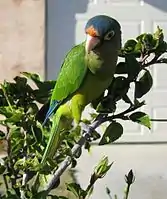 Pet orange-fronted parakeet in garden
Pet orange-fronted parakeet in garden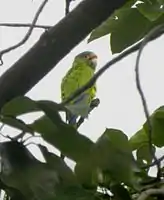 Chocoyo in El Crucero, Nicaragua
Chocoyo in El Crucero, Nicaragua
See also
References
- BirdLife International (2020). "Eupsittula canicularis". IUCN Red List of Threatened Species. 2020. Retrieved 10 December 2020.CS1 maint: ref=harv (link)
- "Zoological Nomenclature Resource: Psittaciformes (Version 9.004)". www.zoonomen.net. 2008-07-05.
- Sanchez-Martinez, Tania; Renton, Katherine (2009). "Availability and selection of arboreal termitaria as nest-sites by Orange-fronted Parakeets Aratinga canicularis in conserved and modified landscapes in Mexico". Ibis. 151 (2): 311–320. doi:10.1111/j.1474-919X.2009.00911.x.
- Kruzer, RVT, LVT, Adrienne. "Half-Moon Conure Species Profile". The Spruce Pets. Retrieved 15 January 2021.CS1 maint: multiple names: authors list (link)
- Stiles, F. Gary; Skutch, Alexander F. (1989). A Guide to the Birds of Costa Rica. Comstock Publishing Associates. ISBN 0-8014-9600-4.
External links
| Wikimedia Commons has media related to Aratinga canicularis. |
| Wikispecies has information related to Aratinga canicularis. |
- BirdLife species factsheet for Eupsittula canicularis
- "Orange-fronted parakeet media". Internet Bird Collection.
- Orange-fronted parakeet photo gallery at VIREO (Drexel University)
- Orange-fronted parakeet species account at Neotropical Birds (Cornell Lab of Ornithology)
- Interactive range map of Eupsittula canicularis at IUCN Red List maps
